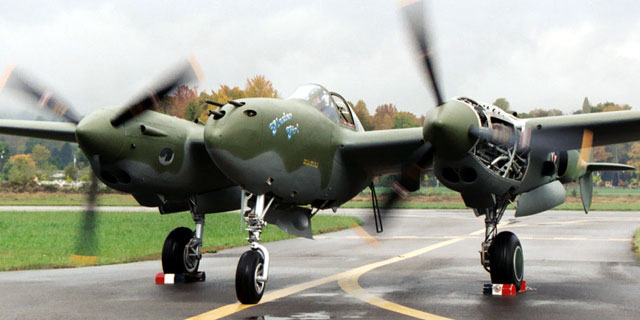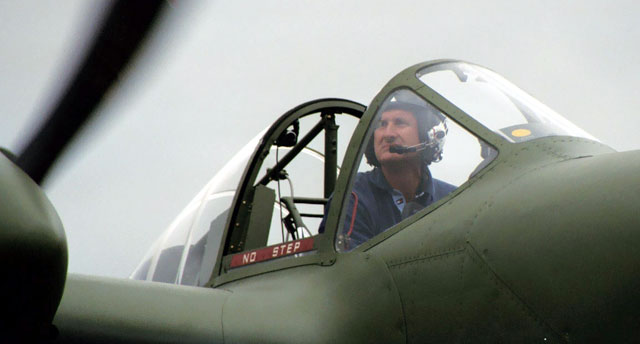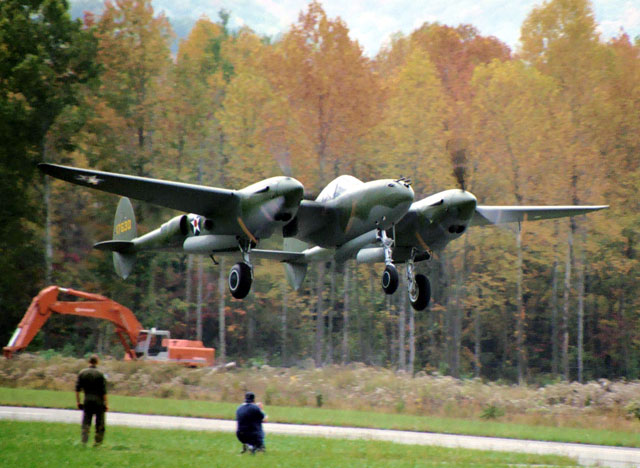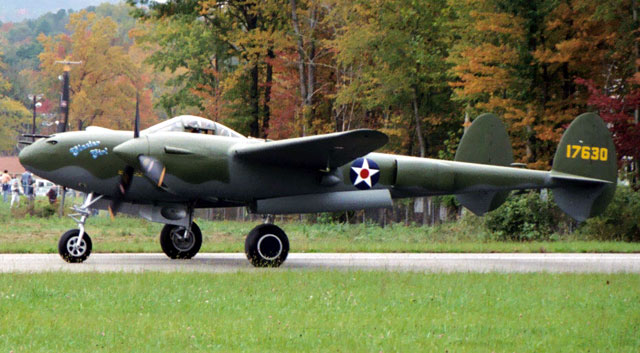|
Glacier Girl
Inaugural Flight of a
Restored P-38F
By Michael H. Horrell
|
 |
|
Lockheed P-38F Lightning
"Glacier Girl" |

HyperScale is proudly supported by Squadron
On October 26, 2002 an early model P-38 took to the air for the first time in
generations.
Rescued from under almost 300 feet of Greenland icecap, the P-38F (now named
“Glacier Girl”) was the subject of a 10-year restoration project by a small, but
highly expert, team of full time specialists at a cost estimated to be in the
range of $6 million USD.
The full story of the recovery has been covered in “The Lost Squadron” by David
Hayes as well as on the team’s website
http://thelostsquadron.com/ and is a truly amazing feat.
My wife and I drove over 400 miles from our home in the Washington, DC suburbs
to Middlesboro in the famous Cumberland Gap area of Kentucky to see this
historic event. We had assumed that a number of military and old airplane nuts
(excuse me, “enthusiasts”) would be there, but we were shocked to find that this
had become a huge event with people from all over North America expected to
attend and all hotel rooms taken for over 100 miles in any direction.
The Kentucky State Police’s official estimate of the crowd was that a minimum of
25,000 people lined the ramps and border fencing of the small, 3,500-foot
airport. Whole families comprising three or even four generations were pressing
against the temporary snow fencing. Some were veterans, some were pilots
themselves, one boy about 10 was there to cover it as a project for his grade
school’s paper, in Wisconsin, hundreds of miles away….
The weather was extremely marginal and the 500 foot ceiling well below the
minimum limits that had been set for the flight. Middlesboro sits in the middle
of a gap in the Appalachian Mountains and the East end of the field is ringed by
steep hills that disappeared into the low, overcast. Almost two hours beyond the
scheduled 2:00 take-off, this low cloud finally lifted to about 1,500 feet and
the flight was on.

Pilot Steve Hinton took off smoothly with the aircraft accelerating rapidly and
breaking ground approximately 1400-1500 feet after starting the take off roll.
He almost immediately began gear retraction and was probably at about 800 feet
crossing the boundary fence. The P-38 airfoil is a surprisingly thick and high
lift profile and the plane climbs in a very flat attitude compared to most
military aircraft.

Steve was immediately joined on the downwind leg by an SNJ chase plane and they
circled the field together several times as Steve went through his pre-planned
checklist.
Once he was satisfied with the aircraft’s operating condition, the SNJ peeled
off and a Piper Seneca photo plane joined up for several more circuits to film
the flight for an upcoming History Channel special. This should be well worth
watching as the formation was extremely tight and the Piper flew in a number of
positions relative to the P-38.
Steve made a couple low passes to the joy of the crowd and then greased the
plane on in a picture perfect landing letting it roll to a stop at the far end
of the field where the crowd cheered loudly enough to be heard mid-field where
we were stationed.

Glacier Girl was experiencing some potential oiling difficulties with the port
engine, which is the reason that the cowling was off. After a second flight the
next day, metal from a disintegrating main bearing was found in the engine
screens and she was grounded pending an engine rebuild. The rebuild should be
nearing completion at this time and hopefully we’ll see her back in the air this
Spring.
Notes for Modelers
The extremely poor lighting conditions have badly affected the in-flight
shots. I had to take my best guess as to exposures and what you see is what you
get under these conditions. I wish they were better…
No color or other adjustments have been made to these photos beyond the
necessary cropping for content. The greenish cast of the OD is ACCURATE and not
a result of exposure or printing. On my PC the color is a very close match to
the Mk I Eyeball’s results. The gray undersurface is also a fairly dark color.
I assume that a high degree of effort was put into accurately matching the paint
pattern and demarcation lines. As can be seen, it is a tight pattern with softly
blended edges. Since the recovered aircraft was virtually brand new and unlikely
to have been touched up, this should be about as close to “gospel” as we are
ever likely to get.
The aircraft's stance. This is how a P-38 is SUPPOSED to sit, not with its tail
almost on the ground. With full tanks, it would squat a bit more but not to an
excessive degree. I knew Ben Kelsey, the original P-38 Project Officer and he
stated repeatedly that this exaggerated stance was largely the result of
over-inflation of the nose strut. I think he was in a position to know what he
was talking about….
The upswept wingtips. They are almost concave in appearance and are surprisingly
similar to the “hollow” tips of modern racing aircraft. Kelly Johnson did not
miss a trick even back then.
The interior structure. This is bare, unpainted metal. If any form of
anti-corrosion coating has been applied, it is not visible to me. FWIW, I saw no
YZC anywhere and I am sure that the utmost care was take to accurately reflect
the original state of the aircraft.
The rear section of the canopy is reinforced by internal Plexiglas strips that
are bonded directly to the clear section.
All panel joints are extremely tight and that is the way these planes were
built. The airframe is extremely flexible (I could see it bobbing and weaving AT
LEAST A FOOT at the end of the booms during full power run-ups) and no doubt
that ha an affect on panel fit and wrinkles. But as delivered, these were
extremely smooth aircraft.
I hope you enjoy these as much as I did taking them.
Mike Horrell
Click the thumbnails below to view
larger images:
Images and Text Copyright © 2003 by
Michael H. Horrell
Page Created 17 February, 2003
Last Updated
19 April, 2004
Back to Reference Library
|
Home |
What's New |
Features |
Gallery |
Reviews |
Reference |
Forum |
Search